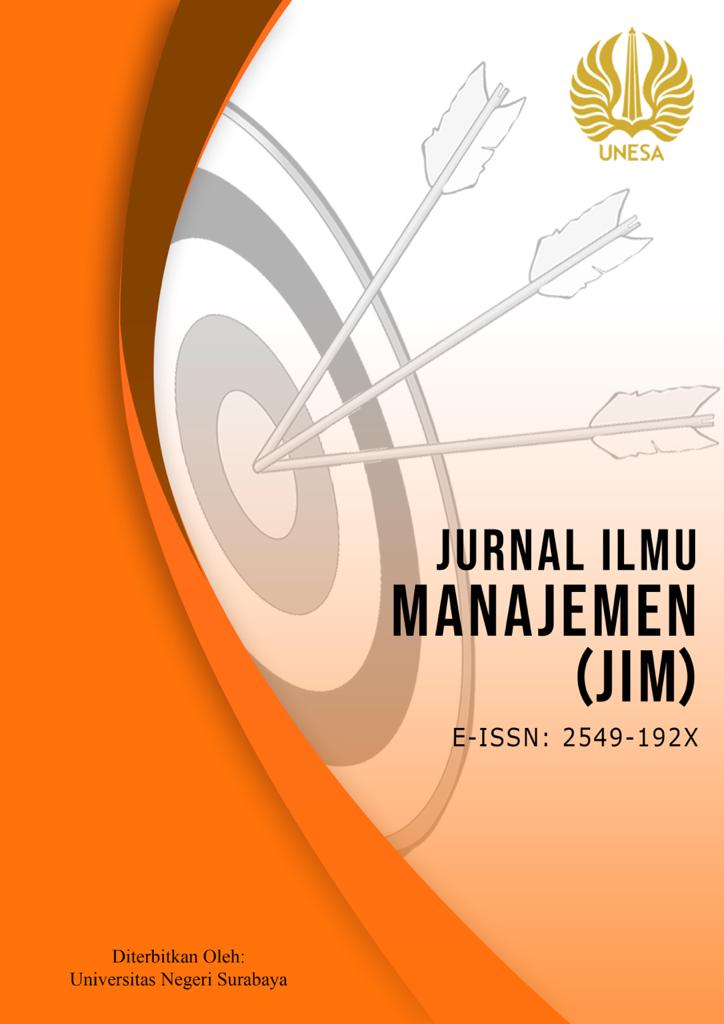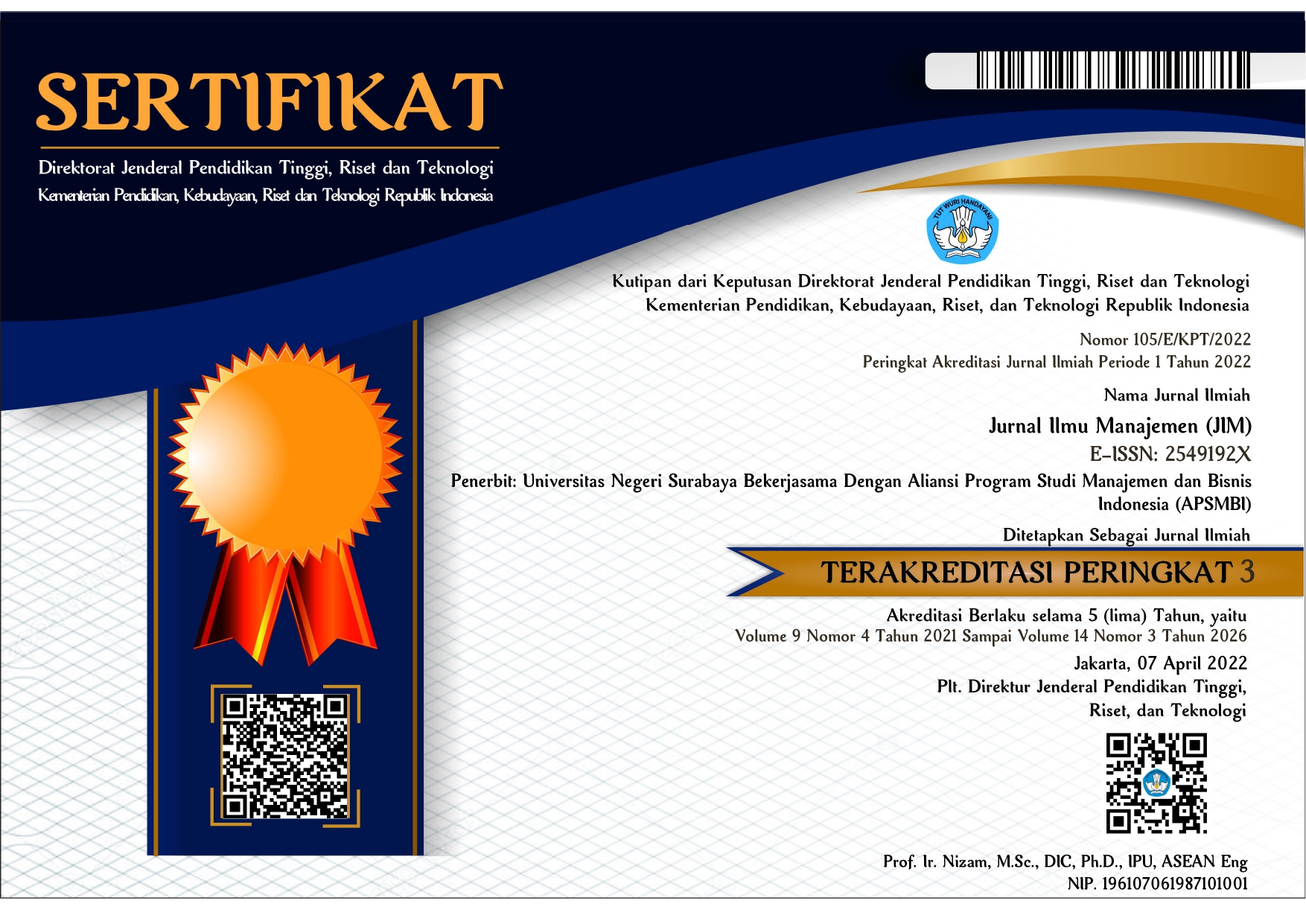Investigasi variabel-variabel yang memengaruhi minat penggunaan QRIS oleh mahasiswa: financial literacy sebagai variabel moderasi
DOI:
https://doi.org/10.26740/jim.v12n2.p451-468Keywords:
financial literacy, mobile payment, QRIS, UTAUTAbstract
This research investigates the factors influencing the use of the Quick Response Code Indonesian Standard (QRIS) among students in the Madura Region, focusing on the role of financial literacy as a moderator. The study utilises the Unified Theory of Acceptance and Use of Technology (UTAUT) framework with independent variables, including performance expectancy, effort expectancy, social influence, facilitating condition, and financial literacy as moderating variables. A quantitative research method is employed, collecting data through a survey using questionnaires from 400 higher education students in the Madura Region. The results of data analysis show that performance expectancy and facilitating conditions significantly influence student interest in using QRIS and can be moderated by financial literacy. Meanwhile, effort expectancy and social influence do not significantly affect behavioural intention and cannot be moderated by financial literacy. This research contributes to understanding the factors that influence QRIS adoption among students and emphasises the important role of financial literacy in using financial technology.
References
Alduais, F., & Al-Smadi, M. O. (2022). Intention to Use E-Payments from the Perspective of the Unified Theory of Acceptance and Use of Technology (UTAUT): Evidence from Yemen. Economies, 10(10), 1-15. https://doi.org/10.3390/economies10100259
Alomari, A. S. A., & Abdullah, N. L. (2023). Factors influencing the behavioral intention to use Cryptocurrency among Saudi Arabian public university students: Moderating role of financial literacy. Cogent Business and Management, 10(1), 1-21. https://doi.org/10.1080/23311975.2023.2178092
Arianti, N. L. N., Gede. Sri Darma, & Mahyuni, L. P. (2019). Menakar Keraguan Penggunaan QR Code Dalam Transaksi Bisnis. Jurnal Manajemen Dan Bisnis, 16(2), 67-78. http://journal.undiknas.ac.id/index.php/magister-manajemen/
Ariyanto, H. H., & Peranginangin, P. (2023). Factors Influencing the Intention to Use Mobile Payment In Indonesia. Manajemen Dan Akuntansi, 26(1), 93-109. https://doi.org/10.35591/wahana.v
Asosiasi Sistem Pembayaran Indonesia. (2022). Berita Statistik Sistem Pembayaran IndonesiaTriwulan I- 2022.
Asosiasi Sistem Pembayaran Indonesia. (2023). Berita Statistik Sistem Pembayaran Indonesia Triwulan III-2023.
Audina, M., Andriana, I., Ekonomi, F., & Sriwijaya, U. (2022). Faktor Yang Memengaruhi Behavioral Intention Transaksi Keuangan Digital (E-Wallet) Pada Generasi Milenial Di Kota Palembang. Media Riset Bisnis & Manajemen, 21(2),99-116. https://doi.org/10.25105/mrbm.v21i2.12895
Badan Pusat Statistik. (2020). Jumlah Penduduk menurut Wilayah, Klasifikasi Generasi, dan Jenis Kelamin, INDONESIA, 2020.
Badan Pusat Statistik. (2023). Jumlah Mahasiswa (Negeri dan Swasta) di Bawah Kementerian Pendidikan dan Kebudayaan Menurut Kabupaten/Kota, 2021 dan 2022.
Bank Indonesia. (2023). BI-Rate Tetap 6,00%: Sinergi Menjaga Stabilitas dan Mendorong Pertumbuhan. Departemen Komunikasi, Bank Indonesia.
Chresentia, S., & Suharto, Y. (2020). Assessing Consumer Adoption Model On E-Wallet: An Extended UTAUT2 Approach. International Journal of Economics, Business and Management Research, 4(6), 232-244.
Dinas Kominfo Provinsi Jawa Timur. (2024). Pemanfaatan QRIS di Jawa Timur Terus Meningkat. Jatim Newsroom.
Hall, J. A., & Liu, D. (2022). Social media use, social displacement, and well-being. In Current Opinion in Psychology 46, 1-6. Elsevier B.V. https://doi.org/10.1016/j.copsyc.2022.101339
Hasan, M., Le, T., & Hoque, A. (2021). How does financial literacy impact on inclusive finance? Financial Innovation, 7(1), 1-23. https://doi.org/10.1186/s40854-021-00259-9
Karniawati, N. P. A., Darma, G. S., Mahyuni, L. P., & Sanica, I. G. (2021). Community Perception Of Using QR Code Payment In Era New Normal. PJAEE.
Lajuni, N., Kasuma, J., & Yacob, Y. (2020). Islamic Financial Products/Services and the Intention to Use. https://www.researchgate.net/publication/344475549
Lin, X., Suanpong, K., Ruangkanjanases, A., Lim, Y. T., & Chen, S. C. (2022). Improving the Sustainable Usage Intention of Mobile Payments: Extended Unified Theory of Acceptance and Use of Technology Model Combined With the Information System Success Model and Initial Trust Model. Frontiers in Psychology, 12, 1-17. https://doi.org/10.3389/fpsyg.2021.634911
Linge, A. A., Chaudhari, T., Kakde, B. B., & Singh, M. (2023). Analysis of Factors Affecting Use Behavior towards Mobile Payment Apps: A SEM Approach. Human Behavior and Emerging Technologies, 2023, 1-13. https://doi.org/10.1155/2023/3327994
Mansyur, A., & Ali, E. M. T. bin E. (2022). The Adoption of Sharia Fintech Among Millenial in Indonesia: Moderating Effect of Islamic Financial Literacy on UTAUT 2. International Journal of Academic Research in Business and Social Sciences, 12(4), 1329-1343. https://doi.org/10.6007/ijarbss/v12-i4/13035
Mouna, A., & Jarboui, A. (2021). Understanding the link between government cashless policy, digital financial services and sociodemographic characteristics in the MENA countries. International Journal of Sociology and Social Policy. 42, 416-433 https://doi.org/https://doi.org/10.1108/IJSSP-12-2020-0544
Neelam, & Bhattacharya Sonali. (2023). Role of Mobile Payment Apps in Inclusive Financial Growth. Neelam & Bhattacharya | Role of Mobile Payment Apps in Inclusive, 17(1), 9-31.
Ng, D., Kauffman, R. J., Griffin, P., & Hedman, J. (2021). Can we classify cashless payment solution implementations at the country level? Electronic Commerce Research and Applications, 46, 1-22. https://doi.org/10.1016/j.elerap.2020.101018
Noor Rahma, D., & Candra Sari, R. (n.d.). The Effect of Financial Literacy, Digital Literacy, Performance Expectancy on Intention Behavior to Use Peer to Peer Lending. Profita: Kajian Ilmu Akuntansi, 9(4), 54-68.
Otoritas Jasa Keuangan. (2022). Hasil Survei Nasional Literasi dan Inklusi Keuangan Tahun 2022.
Penney, E. K., Agyei, J., Boadi, E. K., Abrokwah, E., & Ofori-Boafo, R. (2021). Understanding Factors That Influence Consumer Intention to Use Mobile Money Services: An Application of UTAUT2 With Perceived Risk and Trust. SAGE Open, 11(3), 1-17. https://doi.org/10.1177/21582440211023188
Putritama, A. (2019). The Mobile Payment Fintech Continuance Usage Intention in Indonesia. https://journal.uny.ac.id/index.php/economia
Qu, B., Wei, L., & Zhang, Y. (2022). Factors affecting consumer acceptance of electronic cash in China: an empirical study. Financial Innovation, 8(1), 1-19. https://doi.org/10.1186/s40854-021-00312-7
Rivaldi, R., Pratama, D., & Renny, R. (2022). The Role Of Behavioral Intentions To Use Mobile Banking: Application Of The UTAUT2 Method With Security, Trust And Risk Factors. Dinasti International Journal of Management Science, 3(4), 724-741. https://doi.org/10.31933/dijms.v3i4.1141
Saputro, R. E. H. , & Diyan, L. (2019). Effect of Financial Literacy and Risk Perception on Student Investment Decisions in Jakarta. Review of Management and Entrepreneurship, 3(2). 107-132.
Senyo, P. K., & Osabutey, E. L. C. (2020). Unearthing antecedents to financial inclusion through FinTech innovations. Technovation, 98, 1-14. https://doi.org/10.1016/j.technovation.2020.102155
Sharma, R., Singh, G., & Sharma, S. (2020). Modelling internet banking adoption in Fiji: A developing country perspective. International Journal of Information Management, 53. 1-13.https://doi.org/10.1016/j.ijinfomgt.2020.102116
Sugiharti, H., & Maula, K. A. (2019). Pengaruh Literasi Keuangan Terhadap Perilaku Pengelolaan Keuangan Mahasiswa. In ACCOUNTHINK : Journal of Accounting and Finance, 4(02).
The Global Payments Report 2023. (n.d.). In 2023.
Venkatesh, V., Smith, R. H., Morris, M. G., Davis, G. B., Davis, F. D., & Walton, S. M. (2003). User Acceptance Of Information Technology: Toward A Unified View. MIS Quarterly, 27(3). 425-478
Venkatesh, V., Walton, S. M., & Thong, J. Y. L. (2012). Quarterly Consumer Acceptance and Use of Information Technology: Extending the Unified Theory of Acceptance and Use of Technology. Forthcoming in MIS Quarterly, 36(1). 157-178 http://about.jstor.org/terms
Winata, S., & Tjokrosaputro, M. (2022). The Roles of Effort Expectancy, Attitude, and Service Quality in Mobile Payment Users Continuance Intention. Proceedings of the tenth International Conference on Entrepreneurship and Business Management 2021 (ICEBM 2021), 121-126.
Downloads
Published
How to Cite
Issue
Section
License

This work is licensed under a Creative Commons Attribution-NonCommercial 4.0 International License.
 Abstract views: 1254
,
Abstract views: 1254
, PDF Downloads: 915
PDF Downloads: 915











